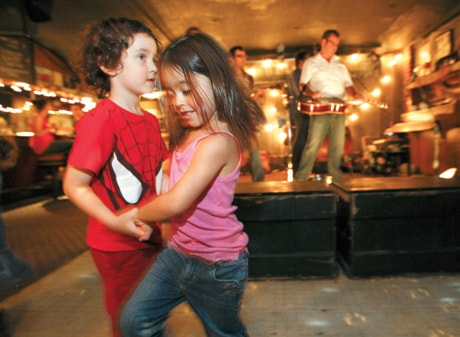TORONTO — Sundays at the Dakota Tavern, families with children line up for live bluegrass and rhythm and blues. Over brunch, preschoolers cram the dance floor.
“It’s totally good times,” says Shauna de Cartier, 42, founder of Six Shooter Records and a regular at the Dakota in Toronto, along with her daughters, Indira, 4, and Fabienne, 6.
De Cartier has no “kids music” in her house. Instead, her family listens to classical, rock and a little bit of hip-hop carefully screened for offensive lyrics, along with lots of the Canadian indie bands De Cartier promotes and produces.
Music for children has an unforgiving way of getting into your head, which is why some parents close their homes to Barney and The Wiggles with a fervour once reserved for the undead.
These days, they’re feeding their children more sophisticated musical fare — bluegrass, rhythm and blues, hip hop and disco, much of it sold by independent artists working out of their own homes, fuelling a small “Kindie Rock,” industry.
It’s all out there: Baby Loves Hip Hop, Baby Loves Salsa, Baby Loves Disco, Bob Marley for kids, bluegrass for kids, and I Can Do It By Myself, a punk rock style sound for kids, with titles like Sugar High and Short Attention Span.
“Seven, my middle name is Kevin; eight, I would love a play date,” rap the dinosaurs in Baby Loves Hip Hop. “I love my granny. She lives in Miami. With her boyfriend Danny,” New Yorker David Weinstone sings in Miami Granny.
Weinstone’s music has become a cult hit in New York, famously earning the endorsement of Jon Stewart of The Daily Show.
“You will listen to David’s music even when your kids aren’t around and, unlike other children’s music, it will not make you angry,” Stewart said.
Serious musicians aren’t surprised by children’s interest in almost all music. After all, the same kind of omnivore attitude toward music is what made them musicians. Eric Clapton grew up listening to opera and American blues on the BBC; Jim Creeggan of the Barenaked Ladies grew up to the background sound of his mom giving piano lessons.
The popularity of bluegrass music among children surprised Dakota Tavern owner Shawn Creamer, but it didn’t surprise Colonel Tom and the Loose Cannons. The band produced a CD of bluegrass songs for children in 2003, and sometimes performs at the Dakota.
“It’s folk music. A really long time ago, everyone listened to it. It was music for the whole family and it was pitched that way,” says Colonel Tom, aka Tom Parker, the music teacher in a junior public school in Toronto.
Weinstone, now a father of three, was struggling in a New York punk rock band and working in a bar when he wrote his first children’s music after his child was born 15 years ago. He thought the methods being used to teach children music were archaic and the music lacking in sophistication.
“Kids are smarter than the music they were being fed. Children have an extremely developed sense of sarcasm — in a good way — by the time they’re three.”
Like Robert Munsch, who put children and how they really think at the centre of his wildly popular books, the children in Weinstone’s songs are in charge. They live in apartments and travel by subway and cab.
Weinstone cites his influences as Patti Smith, Nirvana, the Ramones and Lou Reed. He draws inspiration from Latin music, jazz, pop, country and folk.
Some of his songs, like the popular Runaround Kid, have the raw sound and energy of a garage band. Sometimes the lyrics are just plain silly. “I crack me up until I fall down,” Weinstone sings in one of the tracks from the popular CD “Taxi.”
Weinstone gave his homemade cassettes to members of his parenting group. The music caught on like wildfire, although Weinstone is a long way away from the success of Raffi (the first modern children’s entertainer to reach superstar status) and The Wiggles, the Australian group with DVD and CD sales of 30 million worldwide.
The new kids’ music isn’t limited exclusively to indie bands — Jewel has an album of lullabies for children and the Barenaked Ladies, whose simple and charming lyrics have won them a devoted following over two decades, last year put out their first children’s album, called Snack Time.
It scooped up a Juno in March.
“It turned out to be my favourite record,” says bassist Creeggan, who has a four-year-old son and a one-year-old daughter. “It reminded us of the early records.”
For inspiration, band members turned to their eight children, ranging in age from six months to 12 years, and the dramas that go on in their lives and in their heads.
“Kids really do wanna rock. When they hear something with a strong beat and it’s really all about fun, that speaks to them in a huge way,” says Creeggan.
“My son wants to hear I Can’t Get No Satisfaction. He’s gotta deal with parents and it’s frustrating and he gets to rock out about it.”
That doesn’t mean all music is suitable for kids, says Creeggan — young children might have trouble relating to the content and emotion of Radiohead, for instance.
Music therapists agree that all types of music can be good for children, provided the lyrics are suitable and the music isn’t played too loud.
However, experts say, infants under a year, particular preemies, aren’t ready for intense sounds.
